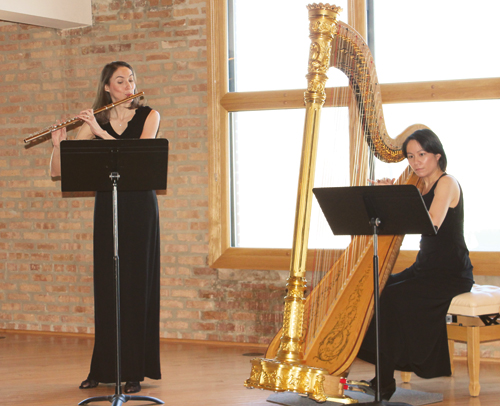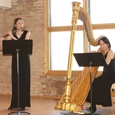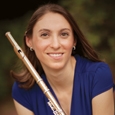
Collaborating with a harpist as a duo or within a larger ensemble presents many rewards and challenges. Understanding more about the harp will help flutists choose appropriate repertoire, prepare well for rehearsals, and perform confidently as an ensemble.
The Harp
The harp, like the piano, can be played as a solo or accompaniment instrument. A concert grand harp has 47 strings covering six and a half octaves, a range almost as large as that of the piano. The strings are laid out like the white keys on the piano and are color coded for identification. The C strings are red, the F strings are black, and all others are a natural color. There are not separate strings that correspond to the black keys on the piano.
In order to play an accidental on the harp, a harpist moves one of the seven foot pedals. There is one for each of the seven notes of the scale. Each pedal has three positions: flat, natural and sharp. When all of the pedals are in the highest position, the strings are tuned to the key of Cb. Moving a pedal to the lower position raises the pitch of the corresponding string.
Using the D string as an example, the top pedal position produces a Db. When the D pedal is pressed down to the middle notch, each disc in the harp’s action corresponding to a D string will rotate, grip and shorten the vibrating length of each D string to create a Dn pitch. When the foot pedal is pressed down to the lowest notch, the corresponding discs in the second row of the action will rotate and create D#. The foot pedals are connected to the action at the top of the harp through rods in the harp’s column. The harp has over 1,000 moveable parts.
The Pedals
The foot pedals are positioned with three on the left: D, C, B, and four on the right: E, F, G, A. This gives harpists the option of changing two pedals at the same time, one in each foot. When watching a harpist play, most people fail to notice the feet, which can be very busy, especially with more chromatic music.
Notation
Harpists read three lines of music at the same time: the right hand, the left hand, and pedal change notation which is marked throughout the piece. For every accidental in the music there is a pedal change followed by a second change to cancel the accidental. Most harpists prefer to mark in their own pedal changes, especially if the composer or editor is not a harpist.
Before beginning a piece, the flutist must wait for the harpist to position all seven pedals according to the key signature of the piece. When rehearsing, a harpist will need to check the pedals for a section before starting. Marking pedal diagrams throughout the harp part makes rehearsals run smoothly. Remember, even with all the fingers on the correct strings, an incorrect pedal will result in a wrong note.
Fingering
Harpists often mark in fingerings, especially in technical passages, much like pianists. However, unlike the piano in which all fingers may be used, the harp is played with the thumb, the index, middle and ring fingers on each hand. The little finger is not used because it cannot reach far enough nor is it strong enough to make a good sound. The fingertips do not touch the surface like a piano keyboard but instead need to wrap around each string in order to pluck it. Harpists read several notes ahead and prepare the fingers by placing them on the strings in groups according to the phrase. This is called connecting the fingers and is marked, along with the fingerings, by brackets in the music. Every string feels the same, so harpists use the red C strings and black F strings for finger placement. When the notes jump beyond the comfortable span of an octave, harpists must look away from the music to visually place the fingers accurately.
Sightreading and Beyond
Because of the intricacies of playing the harp, flutists should not expect to hand a new piece to harpists and expect them to sightread it as easily as other flutists would. Harpists need time to prepare the part before the first rehearsal in order to mark in pedal changes and be aware of the challenges of the work. This is especially important in advanced chamber music, which tends to be more chromatic and rhythmically complex.
Harpists usually sightread at a slower tempo than flutists might prefer. Be prepared to take extra breaths, especially in longer phrases. Once the repertoire is chosen, and rehearsals have begun, unless the harpist has had sufficient time to learn the part thoroughly in advance, expect to gradually work up to the final tempo, otherwise the harpist will sacrifice accuracy or drop notes in order to keep up. Harp parts are generally more complicated than flute parts, so it will take the harpist longer to learn them. Remember that the harpist is reading three lines of music, coordinating pedal changes, preparing the fingers for each note, and looking away from the music at times to visually place the fingers.
While playing under tempo in early practice sessions, take the opportunity to check that rhythms in the flute and harps parts are fitting together perfectly. Listen for intonation and for melodic material in the harp part, which might be obscured within dense chords or arpeggios. When playing a lively piece at a slow rehearsal tempo, be sure to play with the same rhythmic vitality, crisp articulation, and energetic tone that you will use at a performance tempo.
Positioning
Three factors should be considered when deciding how to position each instrument and musician on stage: acoustics, eye contact and visual appeal for the audience. The flute will project best when the end of the flute is pointed more toward the audience rather than to the back of the stage, and the harp will project best when the soundboard is pointed toward the audience.
If other instruments are involved, the acoustic tendencies of each instrument should be weighed to find the ideal solution for the ensemble, while also being sure each musician has clear sight lines for the entire group.
From the audience’s perspective, the position of the harp should be considered, so that the harpist is not hidden behind the instrument. The harp rests on the harpist’s right shoulder, and the music stand is to the left of the instrument. The visible part of the mechanism, called the action, is on the left side of the harp, making that the front of the instrument. This should be the side that is angled toward the audience.
When playing as a flute and harp duo, the ideal set-up is for the harp to be to the flutist’s left. In this position, each instrument is directing its sound toward the hall. In addition, the front of the harp is visible to the audience, and the musicians have a clear view of each other through the harp strings when the instruments are angled correctly. This provides the flutist with a clear view of the harpist’s fingers, which helps to coordinate attacks and tempo changes. It also allows the harpist to peripherally watch the flutist while placing fingers on the strings.
Intonation
Playing in tune with a harp can be a difficult task, and it is a much different experience from playing with a piano, where the pitch is very consistent, or other instrumentalists who can compromise and adjust their pitch as necessary. Harpists need to tune all 47 strings of the harp, and if a string is out of tune, pitch cannot be fixed without stopping and adjusting the string with a tuning key. Even if the harp is tuned meticulously, the pitch will not always hold for an entire performance or even a piece. Flutists should be flexible, listen carefully, and adjust when necessary. During rehearsal or just prior to a concert, don’t hesitate to ask the harpist to check or adjust the pitch of particular strings or chords.
When tuning to the harp, it is recommended that the harpist play a chord in the middle register, for example D minor, to which the flutist can compare the pitch of the notes in that chord. Rather than tuning to a single string, which may be a bit higher or lower in pitch with the rest of the harp, tuning to a chord provides a better representation of the pitch level of the entire harp.
In order to better anticipate the pitch tendencies of the harp, it is useful to understand the intricacies of harp intonation. Harpists tune the instrument with the pedals in the top flat position. If a harp is not regulated by a technician and maintained with new strings every year, even after tuning the strings perfectly in flat position, the natural and sharp pitches created on same string can be off. Additionally, strings might not hold pitch well due to temperature and humidity changes, which cause the wood on the harp to shrink or expand, effecting the tension of the strings. This is particularly a problem when moving the harp from one location to another, which is why harpists prefer to arrive early in order to allow the harp to acclimate to the space. New strings require very frequent tuning and take several days to stretch to the ideal tension.
Flutists should be aware that the highest strings on the harp will sound a bit flat when plucked loudly. Of course, the flute tends to play sharp in the high register, so an even greater effort must be made to bring the pitch down to match the harp when both instruments are playing high and loud. Remember, the harpist cannot adjust the pitch once the piece starts, so the flutist must be aware and make the necessary changes. If there are certain pitches that are consistently problematic, a helpful trick is for the harpist to tune those strings a bit higher from the outset, provided this does not cause any adverse problems in the remainder of the piece.
Become a Great Collaborator
Just as flutists expect collaborators to accommodate the flute’s technical limitations and allow space for breathing and phrasing, other musicians appreciate colleagues who are considerate of their instrument’s challenges. By working closely with a harpist to better understand the harp’s intricacies, you can become a more sensitive collaborator and strengthen your ensemble.






